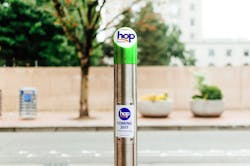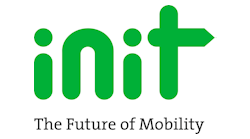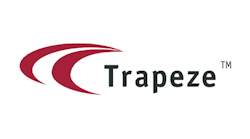Transit agencies in the providence of Ontario are using the Presto card, which was created by Metrolinx to provide a smart card system for riders to board regional buses and trains around the Toronto area. The Toronto Transit Commission (TTC) is taking steps to bring the agency fully on board with Presto by 2017, in an effort to retire the old token system it still uses.
Chris Upfold, deputy CEO for the TTC said the agency agreed to get on the Presto card system in 2013 and has worked on planning and design. In 2015, the agency began to roll out Presto cards at its 69 stations with 26 of them being equipped by the beginning of December.
“This is a transitional period where sometimes you need a paper transfer for a streetcar even if you have a Presto card, or if you’re having to transfer to a bus you need to know if you have to get on at the front door to get a transfer or not,” Upfold said. “This is really one of those moments at this period of time where there needs to be a huge amount of communication with commuters and it’s a challenge.”
This year will be a lot of work for the agency, Upfold said, with running both systems concurrently on a more widespread basis in preparation for the full switch in 2017. TTC is using all forms of communication it can to reach out with the public and educate the public and despite the challenges, slowly rolling out the system instead of one big switch like most transit agencies seemed like a good option, Upfold said.
Alden Cuddihey, global lead and managing director at Accenture Transit and Tolling Services, said they also are opening up the system so more devices can be used for fare collection. By allowing a handheld Motorola device to work in fare collection instead of a device that only does fare collection, it helps in overall cost of ownership.
“Not only is it multimodal, it’s multijurisdictional,” he said. “And it’s also in an environment where you have multiple devices from multiple vendors.”
When looking into the system, Upfold said they considered bolting card readers onto existing gates and integrating legacy equipment with the new technology, but instead it contracted with Scheidt & Bachmann to replace all turnstiles.
“There were a few reasons for this. One was frankly to modernize and two, were much happier with an integrated system,” he said. “We were worried that if we bolted readers onto the old gates how we would handle it if there were problems and ultimately who would be responsible for those issues.
“Also, those gates probably only have another 5-10 years left in them anyways.”
There are about 250 legacy streetcars in Toronto carrying about 350,000 people per day, so putting in a new fare system is a challenge. Upfold said one way the agency is handling it is the implementation of new streetcars that are all equipped to handle Presto card when set in operation.
“Part of the reason is we have had in a separate deal Presto at 12 stations for seven or eight years, so we already set down this path where we could use it in some spots,” he said. “But also, I think that despite the communications challenge and that it would be for our convenience to keep things out of service even though the customer wants to use them isn’t the right thing to do. There will be a lot of trips made using the smart card, some stations already have Presto, so for me to say ‘yes, those are installed, but you can’t use them for months, or years even though it would make things easier for you,’ isn’t the right thing to do.”
Robert Hollis, vice president for Presto, said there was a benefit to start with the smaller transit agencies bordering Toronto because it mitigated a lot of the risks associated with implementation when TTC was finally ready to enter the system.
“We purposely started this program to be as vendor-agnostic as possible,” he said. “There are multiple vendors in the region, so it gives us a lot of freedom when we go out to bid.”
Upfold said there hasn’t been a big financial gain from the Presto switch yet, but the switch is more to drive ridership than to cut costs by using new technology.
“Everybody talks about implementing open payment, but when we took a close look around the world at everyone with open payment, no one actually is fully integrated on options. It gives you the most set of options but not everybody has a debit or credit card anyways and open payment systems being implemented now start as closed-loop systems,” Hollis said. “So we’re starting with the closed loop system, then working in open payment in 2017 when we already have the software put in place by Accenture. It’s just a matter of time for us because one of the real advantages in the Toronto region is we already all have contactless credit cards, we just need to implement the open payment.”
But after the full Presto implantation in 2017, Upfold said TTC is taking it a step further and moving the entire system to an open payment platform.
“It’s almost like we’re one of those countries that skipped the entire landline era and went directly to the mobile era while other countries were going from the landline to the mobile era,” he said. “We’re going directly from tokens into the modern era.”
CAT Fares Get Smart
Charlottesville Area Transit (CAT) in Charlottesville, Virginia, completed an upgrade of its fare collection system in August, replacing old GFI CentsaBILL boxes with new Trapeze EZ Fareboxes allowing for smart cards. Tamara Sears, program manager for fareboxes for Trapeze served as project manager on the CAT project and said the change in fare systems allows the agency to get more data and mitigate potential fraud.
“One of the key things was the EZ Fareboxes get boarding level information through the use of GPS they get to have bus stop level recording,” she said. “They also wanted smart media, so they went from a paper pass system to smart cards immediately after installing the fareboxes.
One thing CAT wanted to know was usage by University of Virginia students of the bus. Student IDs for the university and medical school each had their own unique bar codes, so Sears said they can track both sets of students. Prior to the new system, Sears said riders would flash their ID at a driver who would manually enter the fare on his driver’s screen as a student. However, it also meant little validation the ID was accurate or that drivers weren’t mistakenly entering the wrong type of fare information.
“Now they can say, ‘This is how many rides we’re getting on a daily basis or yearly basis because we know it’s verified,’” Sears said. “There’s a lot more weight to the numbers when they’re processed like that. It’s easier to argue the numbers than when it’s manually generated.”
Sears said there were some complications with getting the UVA information into the transit agency’s system after some of the information they were sent was inaccurate. They worked through the system and made some changes to increase the number of barcode patterns recognized by the fare system. It created opportunities in the long run, she said, because the built-in flexibility from the issue makes it easier to accept other entities into the system, which has come about recently.
There were the typical issues with lead time and vendors in the project Sears said, and there were delays along the way, but patience and keeping a clear channel of communication through the project and launch helped create a strong system and resolve issues as fast as possible.
“We were very ambitious to modify the product and then when we knew we had a deliverable product to Charlottesville, you know, sometimes you have to take a little of the risk and the risk paid off,” she said.
“You have to be in constant communication with the client, lay the facts out there very early on and let them know what’s happening, what’s going on, what this really is, what we’re trying to do, like the bigger display, the QR reader, the UVA issues, you explain it to them and they’re definitely more bound to stick with you,” she said.
TriMet’s Sea Change in Payments
TriMet is implementing a new electronic fare system in 2017 after five years of planning and installation work, with the help of vendors, such as CH2M, Scheidt & Bachmann, GlobeSherpa and Init.
Chris Tucker, director of revenue operations for TriMet, said the agency made plans to roll out an electronic fare system in conjunction with the Portland Streetcar and C-Tran in order to provide an account-based open fare system in the metro Portland, Oregon, area.
The first step in the process in the implementation was the September 2013 rollout of TriMet’s fare payment app, created by GlobeSherpa. The app has been considered successful by the agency with more than 6 million tickets sold through Nov. 3.
“The app has been nice because it puts the tool in the hands of the rider. While it has gotten a lot of great praise from the public, that new system — the app — only works for people with smartphones,” Tucker said. “Now for us, more than 70 percent of our riders have smartphones, which is great, but we need a comprehensive solution for all of our users and for employers.”
The system is branded as the Hop FastPass, which came through a collaborative process between the transit agencies. The name is a nod to the region’s local craft beer industry while also conveying how it eases transfers between systems. It will implement fare caps to help low-income riders and be loadable by cashiers at stores similar to a gift card.
Tucker said TriMet did a lot of peer review of similar fare collection systems in North American and London to see options and best practices learned along the way. They didn’t model it after one particular system, but he said TriMet’s will be similar to the systems used in Chicago and Salt Lake City.
Tucker said TriMet first had looked at the area’s communications infrastructure of the Portland area given its importance in fare collection. Field tests were done at stations and when TriMet determined which cell provider had the strongest service in the region, it opted for that vendor.
“The other concern was the system integrator. They have to do real-time fare collection and they have to do it in a few milliseconds,” Tucker said. “We wrote really tight specs on that.”
Eventually TriMet opted for Init, who is using an open system, so it’s API is available to all third-party vendors involved in the project, so the same API is put into all the equipment. Tucker said there were about 150,000 downloads of the app when it was rolled out, but as the Hop FastPass completes testing in 2016 and comes online in 2017, the agency will work to get more people on the new system.
“As we transition to this new system, there will be an educational process of getting people to switch to this new system,” he said. “Our goal is to create an app that can virtualize your Hop card, so you can tap your phone instead of a card.
“We’re in the early stages of that technology, but we’ve got a long way to go on that.”
VRE Builds a Bridge to NEPP
In May, the Virginia Railway Express (VRE) launched a new mobile ticketing option allowing riders to use their smartphones as tickets. The ticket works primarily as a flash pass, but with security features like animations to keep riders from taking screenshots and pretending it’s a valid ticket.
Chris Henry, director of rail operations for VRE, said the agency began doing an assessment on ticketing options in 2011 after the Washington Metropolitan Area Transit Authority (Metro) began planning for its New Electronic Payments Program (NEPP), which would install an electronic open payment fare system. VRE feeds into Metro and uses magnetic card technology, so Henry said they sent out an RFI, met with more than a dozen different vendors and eventually selected GlobeSherpa for a $1.4 million mobile ticketing option.
Henry said the current fare system is a Scheidt & Bachmann system and one of the stipulations was making sure the mobile data would integrate into the existing system.
“We were looking for a technology that could be that bridge technology to get us from the current system to that interoperability with NEPP once WMATA got it up and running,” he said. “Mobile payment looked like the right
answer for that.”
Due to many rural areas along VRE’s service area, Henry said the agency needed a solution allowing riders to display passes to ticketing agents while offline. The agency also didn’t want to add to its current ticketing staff, so the pass needed to be visually verifiable.
Henry said VRE doesn’t brand its traditional fare system, so it decided to not brand the new mobile ticket as anything other than VRE Mobile. NEPP still isn’t implemented by Metro, but with the generic name, he said it’s hopeful it makes for easier integration with regional partners.
“Within three months of launch, we got to 10 percent of total sales on VRE mobile and right now we’re sitting in the 12 to 13 percent range in terms of fare revenues,” Henry said. “If you look at it in terms of the number of tickets, we’re actually seeing 20 to 25 percent of tickets sold on VRE Mobile, which means we’re getting more of the single ride, day trip, 10-day passes on mobile.”
Getting monthly riders and employers on VRE Mobile is something the agency is pushing in 2016, Henry said, with the challenge coming from the number of government workers using the system. While 95 percent of VRE riders have a mobile device, many with government agencies get a transit subsidy, but there is a process in transferring the subsidy into VRE Mobile. He said there is a process involved with making the transfer and part of VRE’s outreach will involve
education of how to do the process and employees showing riders how to make the switch.
“I think one of our biggest potentials for savings is getting people away from the vending machines,” Henry said. “We pay higher commission fees to our vendors, so one of the improvements is the old ticket vending machines, the TVMs, the cost and the maintenance contract we have with those vendors goes up every year while the system gets older and older.
“We’re in an expansion mode. We just opened a new station and are adding new trains. My goal was that despite the planned service growth and the new platform to be able to use the most of the existing infrastructure, to take the fixed number of assets I have and spread them across the system and not increase the hard capital cost of equipment or increase the cost of maintenance.”

Joe Petrie | Associate Editor
I came to Mass Transit in 2013 after spending seven years on the daily newsbeat in southeastern Wisconsin.
Based in Milwaukee, I worked as a daily newspaper reporter with the Waukesha Freeman from 2006-2011, where I covered education, county and state government. I went on to cover courts for Patch.com, where I was the main courts reporter in the Metro Milwaukee cluster of websites.
I’ve won multiple awards during the course of my career and have covered some of the biggest political events in the past decade and have appeared on national programs.
Having covered local government and social issues, I discovered the importance of transit and the impact it can have on communities when implemented, supported and funded.






